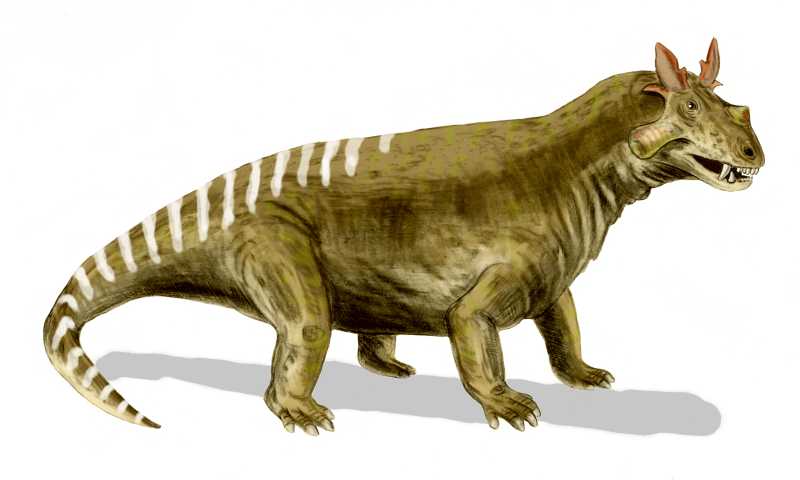- Estemmenosuchidae
Taxobox
name = Estemmenosuchidae
fossil_range =Middle Permian

image_width = 250px
image_caption = life restoration of "Estemmenosuchus mirabilis"
regnum =Animal ia
phylum = Chordata
subphylum = Vertebrata
superclassis =Tetrapoda
classis =Synapsid a
ordo =Therapsida
subordo =Dinocephalia
familia = Estemmenosuchidae
familia_authority = Tchudinov, 1960
subdivision_ranks = Genera
subdivision = "Estemmenosuchus "
"Anoplosuchus "
"Molybdopygus "
"Zopherosuchus "
?"Parabradysaurus "Estemmenosuchidae are a family of large, very early herbivorous
mammal-like reptile s (therapsid s) that flourished during the MiddlePermian period. They are distinguished by horn-like structures, probably for display oragonistic behavior . Apart from the best known genus, "Estemmenosuchus ", the group is poorly known. So far their fossils are known only from thePerm region of Russia (a region referred to by Russian paleontologists as theCis-Urals ).Description
Estemmenosuchids are among the most distinctive of the
Permian tetrapods . The high and massive skull is equipped with a number of horns projecting both upwards and outwards, which were probably used for intra-specific display. Theincisor s andcanine teeth are large, but those at the side are reduced, with a serrated apex, and may have helped to break up plant material, although they were too small to be of much use. The body is large and bulky, indicating a large digestive tract for digesting volumes of plant food. The skull superficially resembles that of "Styracocephalus ", but the "horns" are formed from different bones.Evolutionary Relationships
Estemmenosuchids belong to the
Dinocephalia n group, a group of early, primitive, but diverse therapsids - often of large size - that are known only from the Middle Permian period. They are however far more primitive and unspecialised than the better known dinocephalians of the South African Karoo (Beaufort Group ), and mostly lived somewhat earlier. They are also unusual in that, despite their primitive nature and early date of appearance, they show herbivorous adaptations.Because of this, there have been two main interpretations of their evolutionary relationships with other Dinocephalia.
Hopson and Barghusen in 1986, who provided the first cladistic study of the Therapsida, coined the term
Tapinocephalia for herbivorous dinocephalians, as opposed to the "Anteosaur ia" for the carnivorous forms. They suggested that Estemmenosuchids are very early/primitive members of theTapinocephalia .However
Thomas Kemp (1982) andGillian King (1988) argue instead that the Estemmenosuchidae are the most basal Dinocephalia, being more primitive than both the Anteosauria and the Tapinocephalia.Ecological succession
The Estemmenosuchids replaced the caseids as the dominant
megaherbivore s of theWordian age (middle of the Middle Permian), before being themselves replaced by theTapinocephalidae during theCapitanian age (late Middle Permian).ee also
*
Permian tetrapods References
* Hopson, J.A. and Barghusen, H.R., 1986, An analysis of therapsid relationships in N Hotton, III, PD MacLean, JJ Roth and EC Roth, "The Ecology and Biology of Mammal-like Reptiles",
Smithsonian Institute Press , pp. 83-106
* Kemp, TS 1982. "Mammal-like Reptiles and the Origin of Mammals".Academic Press , New York, 363 pp
* Gillian M. King, "Anomodontia" Part 17 C, "Encyclopedia of Paleoherpetology ",Gutsav Fischer Verlag , Stuttgart and New York, 1988
* Olsen, E. C., 1962, Late Permian terrestrial vertebrates, USA and USSR "Transactions of the American Philosophical Society ", new series, 52: 1–224.
* Rubidge, B.S. & Sidor, C.A. 2001, Evolutionary patterns among Permo-Triassic therapsids. "Ann. Rev. Ecol. Syst." 32: 449-480.External links
* [http://www.palaeos.com/Vertebrates/Units/400Therapsida/300.html Palaeos] - detailed description
* [http://www.kheper.net/evolution/therapsida/Estemmenosuchidae.html Kheper] - an earlier page, which was incorporated into the Palaeos material (above)
Wikimedia Foundation. 2010.
